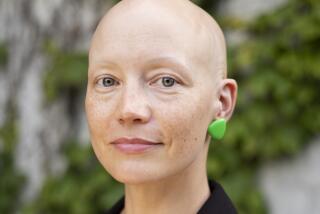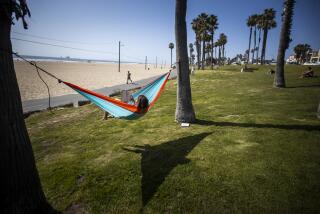‘Bone People,’ fishing and a search for ‘Bait’
- Share via
THE trek to novelist Keri Hulme’s home crosses one of the most remote, wild and beautiful parts of New Zealand’s South Island. The tiny village of Okarito clings to the narrow coastal strip between the Tasman Sea and the sheer wall of the Southern Alps. It has unparalleled views of snow-clad peaks and a tidal lagoon that is the only white heron breeding site in New Zealand.
It’s a place, said Hulme, 58, with “iconic status both among New Zealanders and overseas travelers,” but many are less interested in the wildlife than in her, a quarry who can prove even more elusive. Such is the enduring appeal of Hulme’s first novel, “The Bone People,” winner of the 1985 Booker Prize, that devotees are still beating a path to her door. On this 20th anniversary year of her Booker victory, I went again to visit an author whose book had moved and inspired me (the last time had been on the 10th anniversary). I also wanted to see what progress, if any, had been made on her second novel, which remains unfinished.
The signs that greet visitors are not exactly welcoming: “Unknown cats and dogs will be shot on sight,” and “Unless I know you, or you’ve contacted me first, don’t come in.” They are there to deter casual visitors -- and possibly publishers or Booker Prize judges hoping to find a finished manuscript -- but those who arrive by appointment find her to be far more welcoming than the signs might suggest.
Hulme’s house is a boat-like construction of native wood, hunkered down into the dunes. The huge windows facing the ocean flood the interior with light and provide spectacular views of the land- and seascapes that inspire her. “I can obviously write elsewhere but this is -- the Maori expression is turangawaewae-ngakau -- one of the standing places of my heart.”
She built it with her Booker Prize winnings. The unknown Hulme had been the rank outsider in an international field of literary heavyweights, and while those who loved her book did so with a passion, there was no middle ground; the rest absolutely hated it. She became one of the most controversial winners in the history of the Booker.
“The Bone People,” reissued by Louisiana State University with a new preface by Hulme, revolves around three troubled central characters -- a misanthropic artist, an abused child and a drunken, violent woodcarver -- whose lives become entangled on the South Island beaches of New Zealand. Hulme’s mix of prose and poetry and her use of Maori myth and language (Hulme is of Maori descent) repelled as many readers as it entranced. But what made her win most controversial was that enough jurors favored a newcomer over literary giants such as Iris Murdoch, Doris Lessing and Peter Carey.
In the beginning, Hulme’s novel was almost stillborn. A succession of publishers rejected it, one declaring: “Ms. Hulme certainly can write, unfortunately we don’t understand what she is writing about.” That letter still hangs on her wall. In the end, the book was published by a women’s self-publishing collective. On the strength of word of mouth alone, the first edition of 3,000 copies sold out in six weeks, and the second edition did the same in three days. By then, publishers were clamoring to buy the rights. It has gone on to sell millions of copies worldwide, but since then her readers have had to content themselves with essays, short stories and poetry instead of another novel -- a succession of hors d’oeuvres when most preferred a three-course meal.
This year’s longlist of Man Booker nominees was announced last week, but Hulme’s name wasn’t on it. She is still at work on her second novel, “Bait,” which she calls “a funny novel about death and fishing.” “It’s almost finished,” she once told me, but that was 10 years ago.
It’s tempting to assume that either writer’s block or the sheer numbing weight of public expectation has prevented Hulme from completing a second novel, but she waves that away. “I’m a storyteller, and all modes of storytelling are open to me,” she said. “I have not been doing nothing, but I have not been concentrating only on novel writing.”
But even so, why has “Bait” been so long delayed?
“It’s been a long haul,” she explained, “but writing isn’t my life. My life is my family, my friends, fishing and writing.”
In that order?
She nodded. If a member of her large extended family of siblings and cousins is ever in trouble or needs help, Hulme is quick to respond. Fishing also draws a quick response from her, and she regards it as “an obsession, according to my family, and I’m an extremely keen whitebaiter.”
It’s an obsession shared by her neighbors. As soon as the word goes out that the whitebait are running, they drop whatever they’re doing and head for the fast-rushing creeks and rivers to reap the harvest of the tiny fish, so numerous that their silvery, translucent bodies sometimes fill the water from bank to bank.
“Bait” reflects this obsession. It is set in the fictional town of Takuri, she said, “a small and very ordinary settlement. The 20 or so locals are very ordinary too ... on the surface at least.” They’re keen whitebaiters and there’s a lagoon, which sounds like a portrait of Okarito but, she said, perhaps with one eye on a fresh influx of visitors, “anybody looking for the real Takuri will be grossly disappointed.”
So too will those hoping for a sequel to “The Bone People.”
“ ‘Bait’ is not about tormented, solitary women artists who live in towers; small, [abused], wonderful children; or gloomy would-be carvers,” she said. “It has a broader palette -- a minimum of eight important characters. It is contained fairly tightly within the whitebaiting season, there is a definite surreal element in it and it derives from Maori mythology, but you have to know it fairly well to know the roots of it.”
She smiled. “There are some quite good recipes and tattoo designs in it too.”
Her characters are often “knocking around” in her head for years before they eventually find expression on the page. “Bait” is an example of that.
“Three of the main characters are embedded in a short story written way back in 1978,” she said. “So Charlie, Francis and Bird have been hanging round for an awful long time.”
And can we reassure her long-suffering publisher, who has also been hanging around for an awful long time, that “Bait” will be dropping onto his desk sometime soon?
“Absolutely,” she said at our interview’s end. “Tell him he’ll have it before the end of whitebait season.”
And with that she was off, her fishing gear across her shoulder, striding away barefoot across the chocolate-colored sands of Okarito Beach, two New Zealand icons in perfect harmony.
Of course, Hulme didn’t actually say to which whitebait season she was referring. This year’s season ends Nov. 30, and, despite her self-imposed deadline, her publisher may well be still scanning the horizon for “Bait” when next year’s whitebaiting season comes around again. But for the moment at least, like every year since 1985, “Bait” is still scheduled for publication next spring. *
*
From ‘The Bone People’
AFTER the storm-night, they talked about the tide-washed child.
“I think he likes us,” he had said.
“He needs you ... look at him hold on though he’s not himself yet.”
“Shall we keep him then?” half-joking.
She had answered “Yes!” without hesitation.
“Before our baby? Before our son?”
“Before them all, man,” and she had turned out of his arms and danced, in lumbering triumphant glee.
Then the worm of care had gone. They were whole and sound together until the night they took her away.
It gnaws at him: the last words she gave him as they wheeled her under the flaring lights. Harsh and whispered, “O Ngakau, mind our child.”
More to Read
Sign up for our Book Club newsletter
Get the latest news, events and more from the Los Angeles Times Book Club, and help us get L.A. reading and talking.
You may occasionally receive promotional content from the Los Angeles Times.







